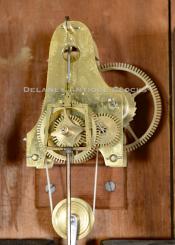Samuel Abbott, Boston, Massachusetts. A gilded framed mirror clock. 221169.
This is an excellent example of a signed mirror clock made by Samuel Abbott while working in Boston, Massachusetts.
It is my experience that gilded mirror clocks are usually found in rough condition. Fortunately, this fine example has beaten the odds. It is in excellent condition. This case is constructed in white pine and finished in various shades of gold paint. At the top of the case is a stepped cornice molding. This molding overhangs the body of the case. The front of the case is hinged and serves double duty as an access door. This front section shares the design of a wall mirror of the same period. It is rectangular-shaped—four raised blocks form the corners. Decorative circular carvings adorn the front surfaces of these square blocks. The linear runs or sides of the frame are in a convex form. A turned and shaped half-column is positioned inside the hollow. This decoration is painted in gold and retains most of the original surface. A wooden cross-member divides the door frame into two sections. The lower section features a period mercurial mirror. The upper section supports a wonderfully painted tablet in excellent original condition. This tablet is painted-decorated from the back and frames the dial. The door will open to allow one access to the case's interior.
The clock components are behind the door. The painted iron dial is slightly convex in form and is signed by the clockmaker, "Samuel Abbot / Boston." The weight-driven movement is framed with "Grand piano" shaped brass plates. Abbott is reportedly the only clockmaker that used this distinctive design. The weight-driven movement is designed to run for eight days on a full wind. The pendulum hangs from the top of the plate and swings in front of the mechanism. The steel rods mounted inside the case guide the cast iron drive weight.
The Clockmaker's set up label is pasted inside the case onto the backboard.
This clock case is nicely proportioned, measuring 34.75 long, 20.25 inches wide at the cornice molding, and 6 inches deep in the same location.
This clock was made circa 1830.
Clocks that share this basic form are often called New Hampshire Mirror clocks. That is not to say that they were all made in New Hampshire, but the vast majority of them were. Over the years, I have heard many old-time collectors claim that more of these were made in New Hampshire than all of the other Northeastern States combined. Let us exclude the Munger and Ives examples. Most of these NH versions were designed to hang on the wall. A few examples were made fitted with a baseboard. This provides clearance when the case is on a shelf or a piece of furniture so the door can swing open. Mirror clocks generally consisted of cases designed in the following manner.
The cases are shallow. The presentation side or front is formatted in the shape and design of a wall mirror. The frames can vary because some feature mahogany veneer, some are paint-decorated, and many others are finished in gilding. They are often visually divided into two sections. The lower section is almost two-thirds of the case length. This area is fitted with a mirror. The upper section displays a round dial framed by a paint-decorated tablet. The artwork is applied from the back. The movement construction can vary significantly based on the individual clockmaker. For example, the Rogers school of clockmakers centered in Berwick, Maine, often made movements featuring iron plates. Abiel Chandler made many striking examples in Concord, NH. Just to the north, in Boscawen, a group of clockmakers favored a movement where the gearing is laid out horizontally. We call this variation a wheel barrel movement. Of course, there are exceptions to every rule.
Inventory number 221169.
Samuel Abbott was born May 14, 1791, in Concord, NH. He was the son of Stephen Abbott and Mary Giles. Samuel began his career as a clockmaker, watchmaker, silversmith, and jeweler in Dover, NH, in 1812. On March 5, 1813, Samuel married Jane Day of Concord, New Hampshire. Together they had two sons. Their son, John Sullivan Abbott, worked in Montpelier, Vermont, in similar trades. The Abbott family moved from Dover to Boston, Massachusetts, in about 1827. Samuel is listed in the Boston Directories as a clockmaker from 1827 through 1830. He is listed at several addresses: first at 11 Pitt Street, then 64 Hanover Street, and lastly, at 33 Merrimack. In 1830, Samuel left Boston and moved North to Montpelier, Vermont. He first advertised himself as a clock and watchmaker there in January 1830. In 1831-32, he partnered with Mr. Freeman as Abbott & Freeman. While in Montpelier, Samuel trained J. G. Hall as a clockmaker. Abbott was again listed in the New England Business Directories as a watchmaker and jeweler at Montpelier in 1849 and 1860. Samuel lived there until his death on May 4, 1861, at the age of 70. He is buried in the Green Mountain Cemetery in Montpelier, VT.
Examples of tall clocks, shelf clocks, New Hampshire mirror clocks, lyre wall clocks, and patent timepieces have been found. He is noted for his distinctive three-pillar, "grand piano" shaped timepiece movements. Many of these clocks are found with a teardrop-shaped pendulum keystone. A watchpaper also survives. It is in the collection of the American Antiquarian Society in Worcester, MA.






















